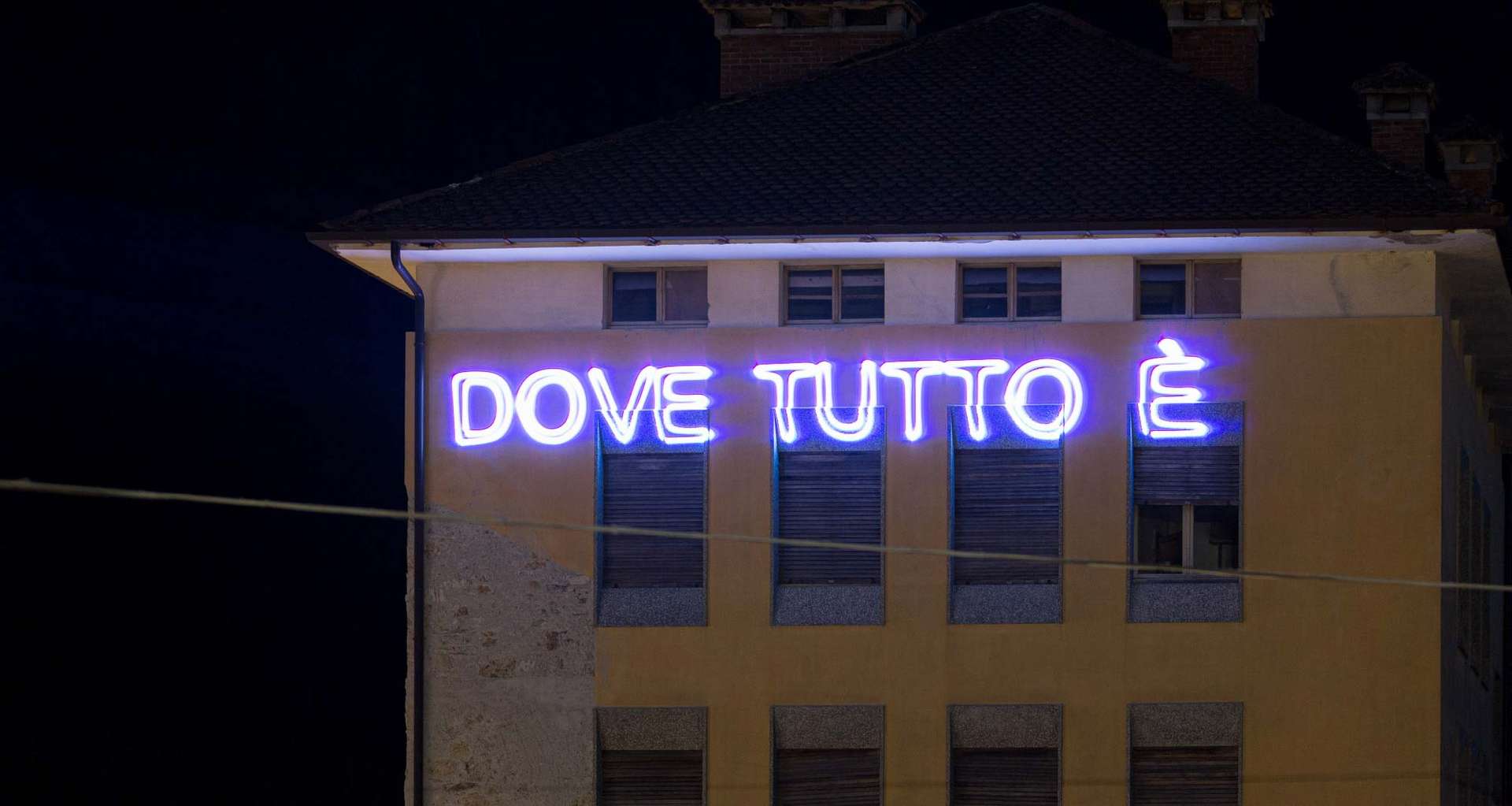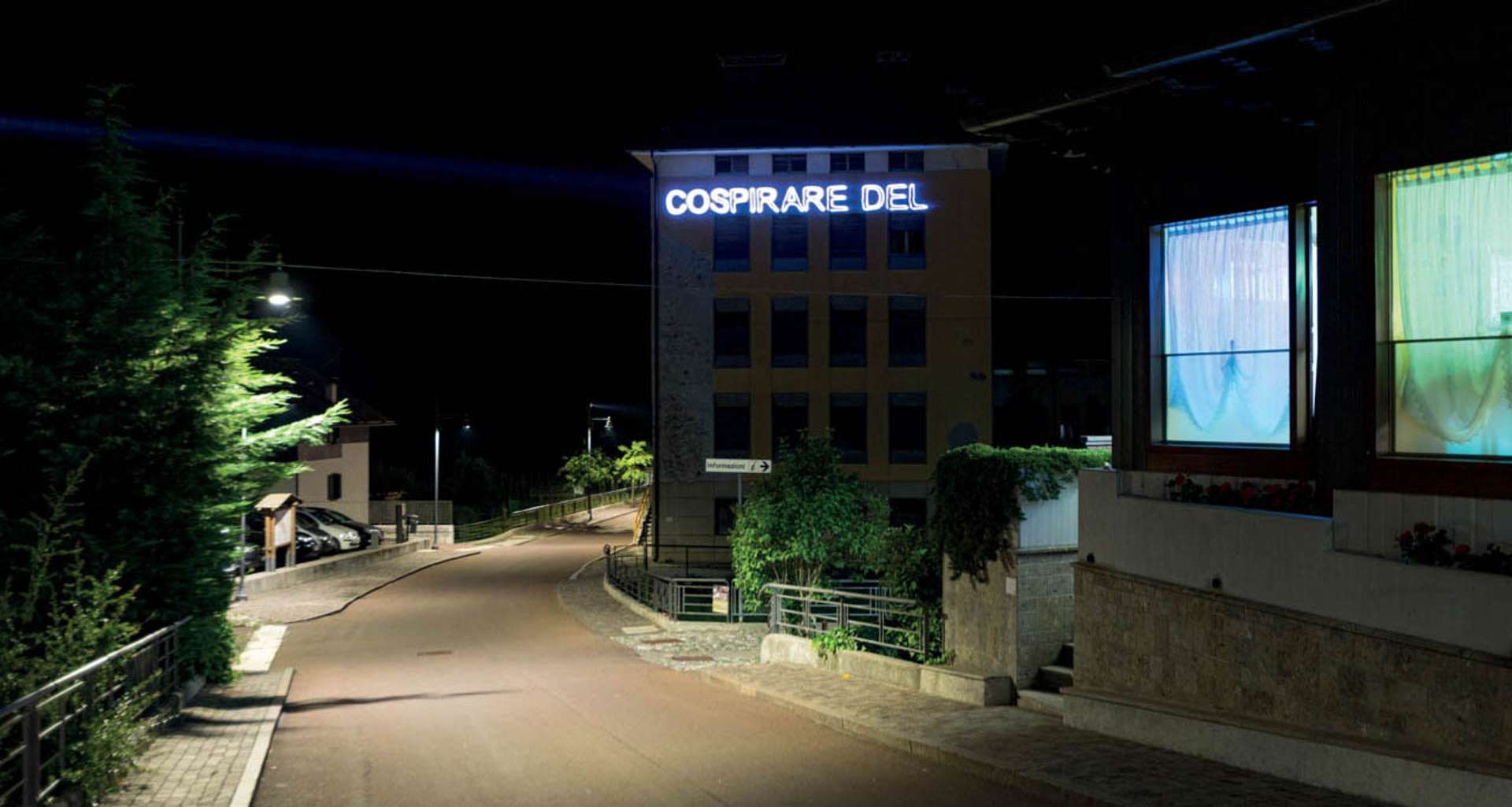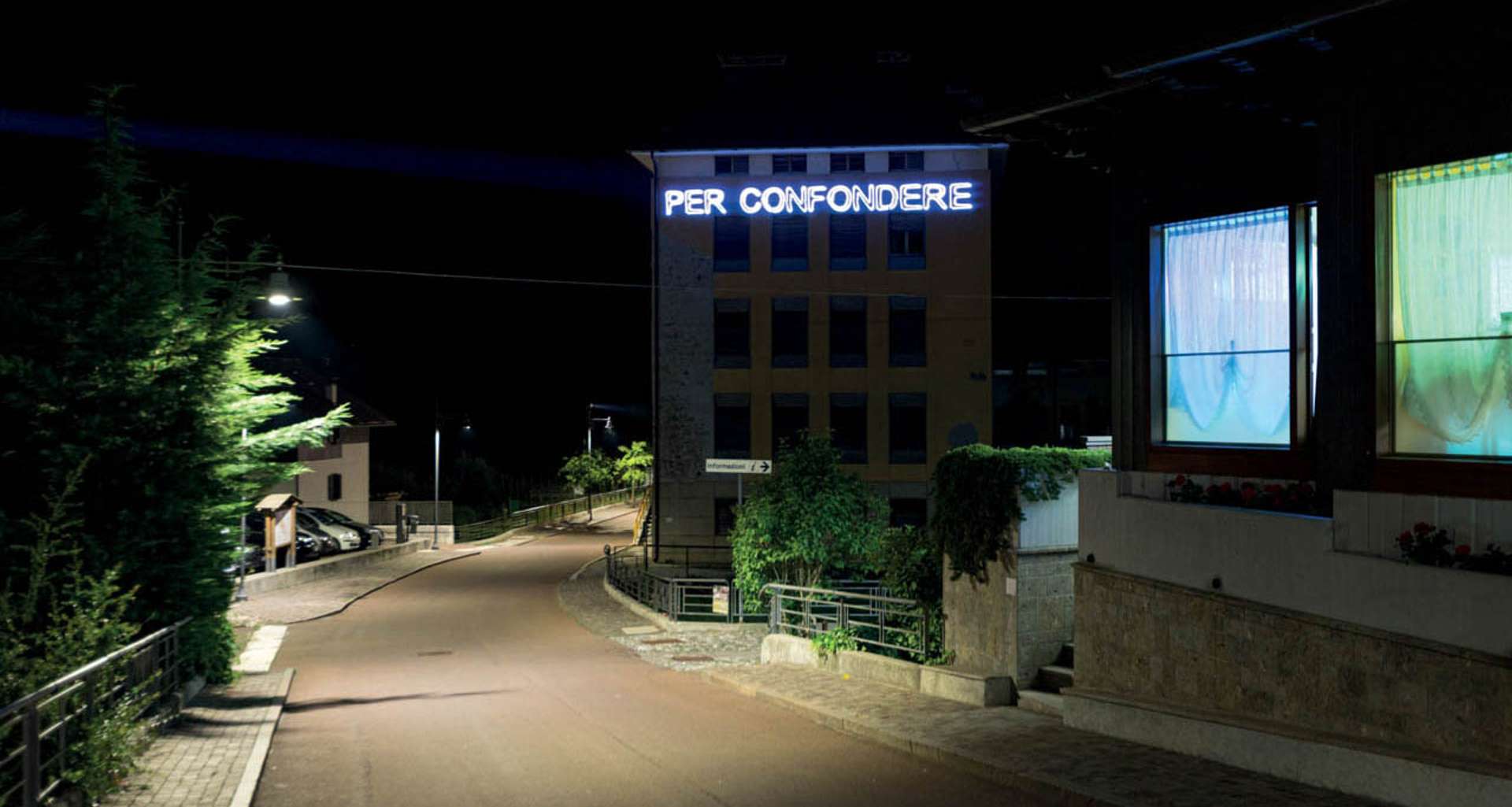Pesariis is the ticking of a multitude of clocks, the rhythmic noise of time.Pesariis is a village of 200 residents in Carnic Friuli. In 1725, the Solari family founded a factory of the same name, making the clock the symbol of this tiny place, Prato Carnico, surrounded by mountains.
The imposing clocks are dotted among the stone houses, differing in colour, mechanism and size. Their dial, tolling, remembers and observes.
Pesariis can also be found in New York, at MoMA, via a Solari clock in the collection. However, it’s by walking through the streets of this village, towards the old school that is now abandoned that, from sunset until dawn, you will see an apparition: a whisper of words that run after each other in echoes.
At night, the written word becomes psycho-sound, or an attempt to transform the stream of consciousness that covers the facade of the large building into spoken word.
A flow that, like ancient storytelling can only be transmitted orally.
Così per dire is a body-less performance, a public installation subject to the cycles of night light, a laser projection that exists in the unproductive hours of the day, inspired by the spirit of coming together and the popular legends connected to this place.
Riccardo Benassi has chosen the Pesariis school as a place to explore, an open theatre where the show begins when the sun goes down, where the spectator attempts to reproduce the projected text verbally, a monologue in first person, where words change from language to language and where clocks embody an onomatopoeia, reminding us of their pivotal role in this town and community.
In his work, Benassi presents to us many of the moments that have been experienced in this village, where the first drops of rain mingle with the ticking of clocks, where meteorological time masks an emotional passing of time.
We are in the land of artists, where technology contributes to our perception of reality and space, where sound and word become living poetry.
"COSÌ PER DIRE" (SO TO SPEAK) IT IS A OF TEXTUAL MEDIA AND ON AN INVENTED DICTIONARY. A WHITE LASER EMISSION SYNCHRONIZES DAILY TO THE CYCLES OF DAYLIGHT OF THE VALLEY AND HEADS TOWARDS THE ABANDONED PUBLIC SCHOOL, LOCATED IN THE CENTER OF PESARIIS: THE HUGE CONCRETE ARCHITECTURE, PERHAPS TEMPORARILY AWAKENED FROM THE APPARENT TORPOR, BECOMES AN EPIPHANIC SURFACE AND READING BASE FOR THE CREATION OF FUTURE PSYCHOSOUNDS
Riccardo Benassi (Cremona, 1982) is a multidisciplinary artist living and working in Berlin and online. His work focuses on the impact of technology in our daily relation to space and how technological devices change the structure of our daily life and organise reality. He implements sound and language through time-based installation, visual poetry, video-essays and architectural interventions. Benassi has been working as professor of Sound Design at the Accademia di Belle Arti Carrara in Bergamo since 2013, from 2014 to 2016 he was a professor of Creative Practices at dBs College in Berlin, and has been guest lecturer at NABA in Milan since 2019.
He has published: Letters from the passenger seat when no one is behind the wheel (Mousse Publishing 2010), Briefly, Ballare (Danilo Montanari 2012), Attimi Fondamentali (Mousse Publishing 2012), Techno Casa (Errant Bodies 2015), Sicilia Bambaataa (NERO Publishing 2015), Morestalgia (NERO Editions 2020).
His work has been shown in public and private spaces in Italy and across the globe. Some of his recent shows by him include: Macro, Rome (2022); Biennale de l’Image en Mouvement, Genève (2021); MoCA Taipei, Taiwan (2021); Museion, Bolzano (2020); ZKM | Zentrum für Kunst und Medien, Karlsruhe (solo show) (2020), Lo Schermo dell’Arte (2020), Center d’Art Contemporain Genève (solo show) (2019), Live Arts Week / ART CITY Bologna (2020), ICA, Milan (2019); IIC Melbourne (2019); Galleria ZERO …, Milan (2019); Impakt festival, Utrecht (2019) ; MAMbo Bologna (2018); Parc Saint Léger, Guérigny (2018); ArtLine, Milan (2018); Kunstraum Potsdam, Berlin (2017); Künstlerhaus Bethanien, Berlin (solo show) (2016).
HOWEVER, IT’S BY WALKING THROUGH THE STREETS OF THIS VILLAGE, TOWARDS THE OLD SCHOOL THAT IS NOW ABANDONED THAT, FROM SUNSET UNTIL DAWN, YOU WILL SEE AN APPARITION: A WHISPER OF WORDS THAT RUN AFTER EACH OTHER IN ECHOES. AT NIGHT, THE WRITTEN WORD BECOMES PSYCHOSOUND
Pesariis, a hamlet of the municipality of Prato Carnico, in the province of Udine, is a small village in the Val Pesarina (also known as the valley of time) of about 200 inhabitants. The village has preserved the typology and structural set up of its original urban centre in this mountainous region. Pesariis is known as the land of the watches: there are documents that testify the watchmaking production of this village from the beginning of the seventeenth century. In 1725, the Solari family founded under their family name a factory for the production of watches. This factory is still operating today.
A walk through the streets of the town, among the ancient Carnic (From Carnia, meaning from the Eastern Alps) houses, allows you to discover a variety of imposing clocks, each one different from the other in size, colour, characteristics, mechanisms and operating modes that form the Monumental Watchmaking Route: great for those who love walking at a slow pace, marked quite literally by the tolls of time, it’s an evocative route that blends art, craftsmanship and technology and that harmoniously interacts with the most picturesque corners of the village. In Pesariis, you will also find the Watchmaking Museum which documents the centuries-old watchmaking tradition of the valley. A collection that traces the technological evolution of Pesariss’ watchmaking from the oldest to the most recent watch models: watches in forged iron, watchtowers, paddle clocks, timepieces, right up to the Cifra 3 model which is part of the collection of objects of design by the Museum of Modern Art in New York.







